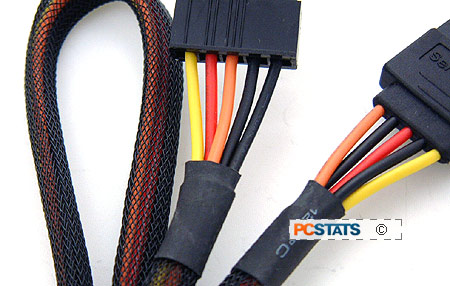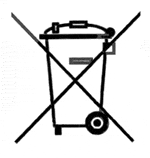Computers have become the latest objects to walk down
the fashion statement path. Your PC and the components inside it
no longer have to just be "good," they also have to look trendy. Every
component up from the motherboard itself, and right on to
the power supply has got to be modern, clean, and
well design to complete the whole "high tech computer" look. For 2006, the trend is modular components. So if you're PC's power supply cables are still.... sheesh... attached by wires, then you've just committed a PC fashionista crime akin to wearing penny loafers to a White Stripes gig.
Setting tech trends aside, modular power supplies do
make sense for a lot of very valid reasons. If you're like most people, a
good percentage of all the power cables snaking their way from the
powersupply go unused in the typical PC system. Good high end power
supplies come with a lot of power cables, but after it is installed whatever is
left over just takes up space and turns into a rats nest of electrical wire.
The thought behind modular power supplies is that you wouldn't walk out the door wearing every item of clothing you own, so why keep all those unused power cables too?. Keeping the inside of a trend-setting PC clean is important, especially if space is limited and that's where the beauty of a modular cable design comes in. Simply hook up only as many cables as you need!
The idea is so simple that modular power supplies
have taken off like wildfire and now virtually every power supply
manufacturer offers at least one model in their product line up.
If you read PCSTATS often you'll know that we think Seasonic is an awesome efficient power supply manufacturer. The company has recently stepped into the modular PSU world, and the first of this series is the Seasonic M12 line; PCSTATS will be testing the 700W model in particular.
Seasonic's M12 700W powersupply has not been
officially SLI certified by nVidia however it's most likely due to the power
supply being brand new and not tested yet. The M12 700W is just about to
hit the retail markets, and when it does it is expected to retail for about
$240 CDN ($214US, £113GPB). Considering what you get in the M12 700W though,
that's still a pretty good price from a well proven powersupply manufacturer that focuses on power efficiency as much as appearance.
The
Seasonic M12 700W power supply conforms to the standard ATX dimensions (139
x 150 x 85mm) which is good news if you're using a compact PC case. Many of the
enthusiast class power supplies that are 500W or more are physically longer
than the standard PSU footprint, and at times this causes space restrictions by
the optical drives.
The Seasonic M12 700W has one large 120mm intake
fan mounted on the top, and one smaller 60mm temperature activated
intake fan mounted by the cable patch. It's important that neither fan is blocked.
The M12
700W sports a native 24 pin ATX power connector which by design is still
compatible with older 20 pin motherboards, because pins 21-24 are detachable. On a
side note, it's nice how power supply manufacturers are looking out for consumers
by including four case screws in the box too.
 According
to the Seasonic label, the +3.3V line will deliver a maximum of 24Amps while the +5V rail
can deliver 30Amps. Total output for the +3.3V and +5V rails is 170W combined.
According
to the Seasonic label, the +3.3V line will deliver a maximum of 24Amps while the +5V rail
can deliver 30Amps. Total output for the +3.3V and +5V rails is 170W combined.
There are four +12V rails on the
M12 700W, and each delivers a maximum of 18Amps, with total power output of 672W.
While the amperage ratings might appear a bit low at
first glance, it's important to make the distinction that Seasonic lists
sustained Amperage values, not peak.
The M12
700W makes use of Active Power Factor Correction
(A-PFC) to improve power efficiency, reduce heat,
and use consume less electricity. A-PFC circuitry eliminates the need for
an external voltage level switch (115/230) on the powersupply as well, since it automatically works
with a wider voltage range (115VAC of North America to 230VAC of Europe)
by default.
Green power supply, the
M12 700W is RoHS compliant
You may
have started to notice a little garbage can with an X running through it on
appearing on motherboards, videocards and other electronics circuit boards this
year. It's a symbol used to represent Directive 2002/96/EC on Waste
Electrical and Electronic Equipment, but it's also generally associated
with Restriction of Hazardous Substances (RoHS) compliance as well. The latter is a European
Union initiative which targets hazardous materials in
consumer electrical and electronics equipment.
 RoHS aims to remove heavy metals used in
electronic components like Lead, Mercury, Cadium, Hexavalent Chormium, PBB and
PDBE. In order to comply with EU's RoHS legislation, all substances must either
be removed or reduced to within maximum permitted levels. This applies to all
electrical components that will be sold within the European Union, so as a by
product most electronics headed for North America are now also made
compliant.
RoHS aims to remove heavy metals used in
electronic components like Lead, Mercury, Cadium, Hexavalent Chormium, PBB and
PDBE. In order to comply with EU's RoHS legislation, all substances must either
be removed or reduced to within maximum permitted levels. This applies to all
electrical components that will be sold within the European Union, so as a by
product most electronics headed for North America are now also made
compliant.
RoHS was originally discussed in the European Union in July of 2003 and was
introduced as law as of July 1st 2006. Manufacturers caught putting
non-compliant products onto the EU market will face stiff fines and have their
products barred.
While manufacturers are primarily affected by RoHS, the law is also seeking
to change how we as consumers handle our old electronics at the end of its life
cycle. End users are advised to handle electronic waste as "hazardous waste",
and dispose of old electronics through proper waste channels - not simply toss
these items into the trash. It is no longer okay to just throw old computer gear
into the dust bin, and subsequently our land fills.
Now that we've covered all of that, let's
take a closer look at the M12 700W powersupply from a couple different
angles, and take a quick peek inside...

